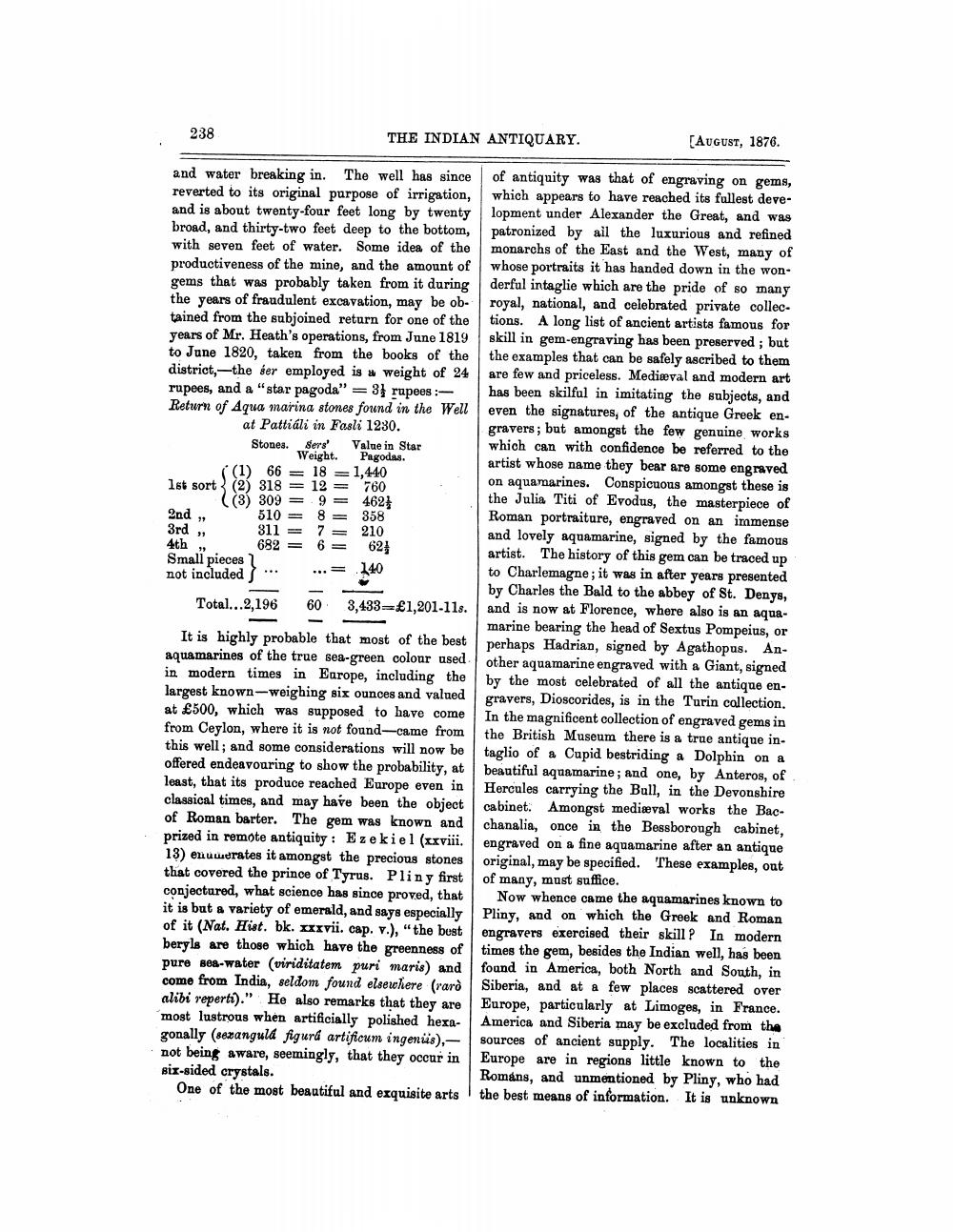________________
238
THE INDIAN ANTIQUARY.
[AUGUST, 1876.
and water breaking in. The well has since reverted to its original purpose of irrigation, and is about twenty-four feet long by twenty broad, and thirty-two feet deep to the bottom, with seven feet of water. Some idea of the productiveness of the mine, and the amount of gems that was probably taken from it during the years of fraudulent excavation, may be ob. tained from the subjoined return for one of the years of Mr. Heath's operations, from June 1819 to June 1820, taken from the books of the district,--the ser employed is a weight of 24 rupees, and a "star pagoda" = 3} rupees :Return of Aqua marina stones found in the Well
at Pattiali in Fasli 1230. Stones. Sers' value in Star
Weight. Pagodas. ((1) 66 = 18 = 1,440 1st sort 2) 318 = 12 = 760
(13) 309 = 9 = 462} 2nd, 510 = 8 358
811 = 7 210 4th 682 =
= 62; Small pieces not included ... ... = 140
Total...2,196 60 3,433=£1,201-11s.
3rd
-
-
2
It is highly probable that most of the best aquamarines of the true sea-green colour used in modern times in Europe, including the largest known-weighing six ounces and valued at £500, which was supposed to have come from Ceylon, where it is not found-came from this well; and some considerations will now be offered endeavouring to show the probability, at least, that its produce reached Europe even in classical times, and may have been the object of Roman barter. The gem was known and prized in remote antiquity : Ezekiel (xxviii. 13) enumerates it amongst the precious stones that covered the prince of Tyrus. Pliny first conjectured, what science has since proved, that it is but a variety of emerald, and says especially of it (Nat. Hist. bk. xxxvii. cap. v.), "the best beryls are those which have the greenness of pure sea-water (viriditatem puri maris) and come from India, seldom found elsewhere (rarò alibi reperti)." He also remarks that they are most lustrous when artificially polished hexagonally (sexangula figura artificum ingenis),not being aware, seemingly, that they occur in siz-sided crystals.
One of the most beautiful and exquisite arts
of antiquity was that of engraving on gems, which appears to have reached its fullest development under Alexander the Great, and was patronized by ail the luxurious and refined monarchs of the East and the West, many of whose portraits it has handed down in the wonderful intaglie which are the pride of so many royal, national, and celebrated private collections. A long list of ancient artists famous for skill in gem-engraving has been preserved; but the examples that can be safely ascribed to them are few and priceless. Mediæval and modern art has been skilful in imitating the subjects, and even the signatures, of the antique Greek engravers; but amongst the few genuine works which can with confidence be referred to the artist whose name they bear are some engraved on aquamarines. Conspicuous amongst these is the Julia Titi of Evodus, the masterpiece of Roman portraiture, engraved on an immense and lovely aquamarine, signed by the famous artist. The history of this gem can be traced up to Charlemagne; it was in after years presented by Charles the Bald to the abbey of St. Denys, and is now at Florence, where also is an aquamarine bearing the head of Sextus Pompeius, or perhaps Hadrian, signed by Agathopus. Another aquamarine engraved with a Giant, signed by the most celebrated of all the antique engravers, Dioscorides, is in the Turin collection, In the magnificent collection of engraved gems in the British Museum there is a true antique in. taglio of a Cupid bestriding a Dolphin on a beautiful aquamarine; and one, by Anteros, of Hercules carrying the Bull, in the Devonshire cabinet. Amongst medieval works the Bacchanalia, once in the Bessborough cabinet, engraved on a fine aquamarine after an antique original, may be specified. These examples, out of many, must suffice.
Now whence came the aquamarines known to Pliny, and on which the Greek and Roman engravers exercised their skill? In modern times the gem, besides the Indian well, has been found in America, both North and South, in Siberia, and at a few places scattered over Europe, particularly at Limoges, in France. America and Siberia may be excluded from the sources of ancient supply. The localities in Europe are in regions little known to the Románs, and unmentioned by Pliny, who had the best means of information. It is unknown




